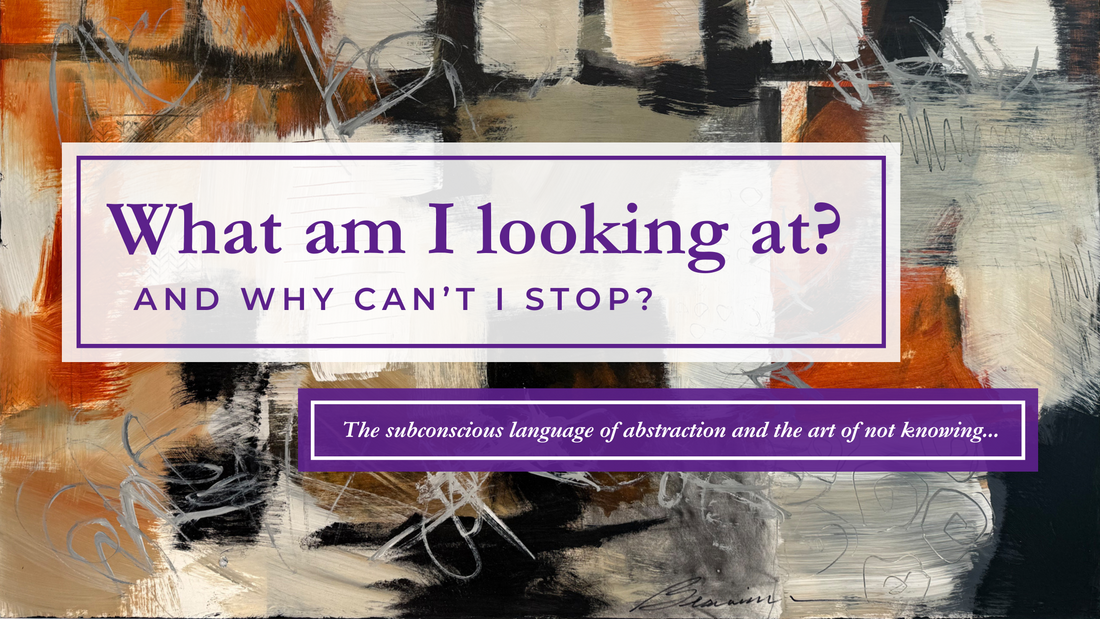
What Am I Looking At? (And Why Can’t I Stop?)
Share
The subconscious language of abstraction and the art of not knowing...
Walk into Mark // Mind, and you might catch yourself squinting, not out of confusion, but curiosity. What am I looking at? What does it mean? Why is it here?
This reaction is more honest than you think. Abstract art rarely gives you a clear entry point. No faces. No landscapes. No easy narratives. For many, that can feel frustrating. Or even a little suspicious, as if the artist is playing a game and you’re missing the rules. After all, couldn’t a child do that?

Dreamsicle (24" x 36") acrylic painting with gold leaf on canvas by Heather Wolynic.
It’s a fair question. At first glance, a field of smudges or loose brushstrokes may seem like less effort or skill than a realistic portrait. But abstraction isn’t about showing what the world looks like, it’s about showing what it feels like. And that demands an entirely different kind of mastery.
Think of abstract art as a language. But instead of grammar and vocabulary, it’s built on color, movement, texture, and gesture. The marks themselves — intuitive, imperfect, and deeply personal — carry emotional weight. They point toward something real, but unspoken.

How to Choose (24" x 36") acrylic painting on canvas by Brandon Santiago.
This is especially true of the work showcased in Mark // Mind, where the connecting thread of the artworks, and the artists who created them, is intuition. Brandon Santiago’s layered forms emerge like remembered dreams; Annie Scull’s tangled strokes feel less like depictions and more like the nervous system externalized. Beau Wild moves between fragility and tension with remarkable control, yet the works never feel controlled in the rigid sense. They’re alive. Which is precisely the point.

Beneath the Noise, The Whisper (25" x 42") acrylic painting on panel by Beau Wild.
The artists in this show aren’t telling you what to see. They aren’t coding secret meanings into their canvases like puzzles to be solved. In many cases, the artist doesn’t even know what the piece is about until long after it’s finished — if at all. That’s not laziness or vagueness; it’s honesty. It’s the willingness to let the subconscious speak before the intellect interrupts.
And here’s the thing: your subconscious understands this language too.

Dissociative (24" x 20") acrylic and spray paint on canvas by Annie Scull.
You don’t need an art degree to feel a pull toward a certain piece. You don’t need to name the emotion that bubbles up when you stand in front of an artwork. In fact, not naming it is sometimes the most truthful response. The value isn’t in decoding, it’s in experiencing.
This is why a Mark Rothko looks like almost nothing online; but, in person, it can completely undo you. It’s not the image, it’s the space it creates. The permission it gives you to feel something unstructured, unscripted, and deeply yours.

Christie’s staff member looks at Mark Rothko’s No 11 (Untitled), London, 2013. Photo by Peter Macdiarmid.
Collectors often talk about resonance, that moment when a piece doesn’t just “match the couch,” but matches something in them. Something that doesn’t yet have words. Abstract art gives form to that silence.
So the next time you find yourself asking, “What am I looking at?” try asking instead, “What am I feeling right now?” Let the marks speak. Let your mind loosen. Not everything in life has to make sense to matter.
Sometimes, the art that doesn’t tell you what to think is exactly the art that stays with you longest.

1 comment
Explained beautifully!